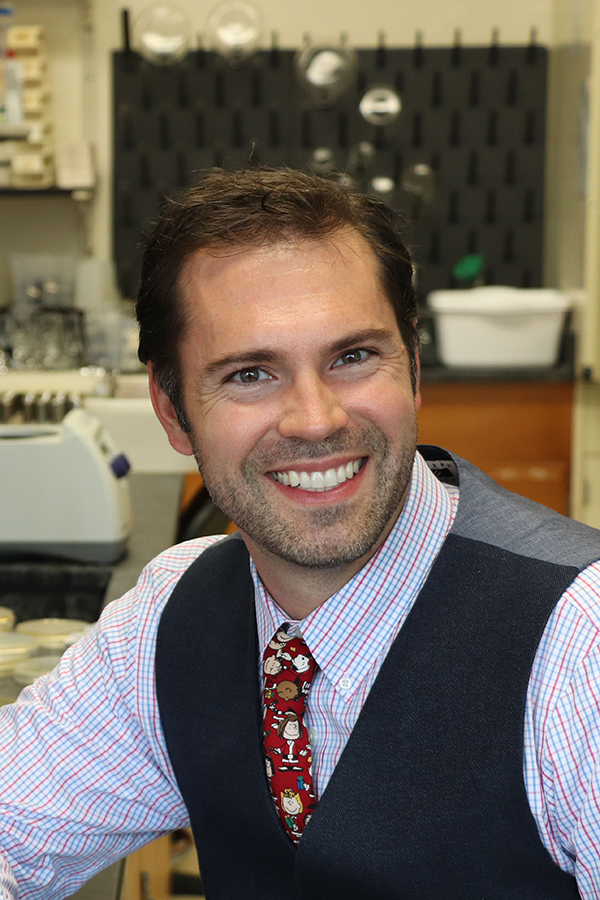
NIH awards $1.7M to microbiology research team headed by Dr. Matthew Cabeen
Friday, November 13, 2020
The start of Fall semester brought some unexpected happy news for Dr. Matthew Cabeen of OSU’s Department of Microbiology and Molecular Genetics: the National Institutes of Health accepted his grant proposal and awarded his research team $1.7 million over five years to study how a bacterium senses and responds to stress.
“Our model organism, a ubiquitous, non-pathogenic species called Bacillus subtilis, has an unusual way of sensing stress in its environment,” Cabeen said. “It uses relatively large multiprotein complexes called ‘stressosomes’ that are inside the cells — each cell contains 10-20 of them — to respond to stresses that are outside the cell in the environment, like ethanol, salt or antibiotics.”
Cabeen explained that because they don’t know exactly how this process works, their “research is aimed at a bottom-to-top understanding of environmental stress-sensing, from the sensor proteins in these complexes to the fitness and survival of a whole cell population.”
He added that the idea for this study grew from research he did as a postdoctoral fellow at Harvard, where he observed that “stressosomes act as a sort of processor — you give them an input and then they process it to yield a different output.”
“The central question of, ‘How do stressosomes sense and process stress?’ was the basis for all of the ideas in the project.”
Because the research Cabeen and his team are working on is “basic science,” he said the results won’t necessarily affect people directly.
“However, the more we learn about bacterial stress responses, the better equipped we will be to either fight against pathogenic bacteria — for example, the food-borne pathogen Listeria monocytogenes also uses stressosomes to sense environmental stress — or to use microbes to make medicines and other useful products,” he said.

The members of Cabeen’s research team include postdoctoral fellow Dr. Simon Underhill, Ph.D. students Rabindra Khadka and Chris Hamm, Niblack Scholar Sid Bush, and several undergraduate students.
“Rabi, Chris and Sid actually helped generate some of the preliminary data that we used in the proposal,” Cabeen said. “My crew is smart, hardworking and fun-loving, and so going into the lab every day is a delight for me. They’re already making great progress.”
Khadka expressed similar appreciation for Cabeen, explaining that the professor has given his students unique opportunities for learning and growth.
“He is very supportive,” Khadka said. “He provides full, informative feedback about the experiments and results. … He allows us to present our research work at various symposiums and international conferences. It is under his supervision that I got my first opportunity to present my work at an international conference, which helped me grow in confidence.”
As a result of working just one semester in Cabeen’s lab as an undergrad, Hamm actually changed career path. He had originally planned to apply to medical school, but “ended up staying here to do a Ph.D. under Dr. Cabeen instead. I am now in the third year of my Ph.D. program.”
“When Dr. Cabeen talks about science, you can feel how much he enjoys it and how excited he gets about new ideas,” Hamm continued. “He is very passionate about science and is always up for a discussion about new ideas, how something works — anything really. He makes the lab an enjoyable place to work and a healthy learning environment.”
Like Hamm, Cabeen also altered course on his career path as he finished dual bachelor’s degrees from the University of Connecticut in diagnostic genetic sciences and molecular cell biology.
“I thought I would be a genetic technologist, but then fell in love with research,” Cabeen said. “Immediately after graduation I enrolled in graduate school at Yale University.” After earning his Ph.D., he then did a postdoctoral fellowship at Harvard.
“Neither of my parents went to college, so it was sort of a surprise that I ended up going to graduate school,” he said. “I have my mentors to thank for that.”
Cabeen added that his goal early on at Yale was to become a professor, which has allowed him to combine his love of teaching and research. And now, with his newly awarded NIH grant, he can more easily continue those endeavors.
“I’m really pleased to say that this grant is part of a great funding trend for the department,” said Cabeen, noting Department of Microbiology and Molecular Genetics faculty members average over $2 million in research grants annually.
“Those dollars pay graduate students and postdoctoral researchers and enable us to buy the supplies and equipment we need to get research done. Grants like this also really help OSU improve its research profile in every way — they help us to recruit talented new faculty and students, which in turn helps us to receive more funding down the road. And the end goal of having talented and well-funded teams of researchers is to make exciting discoveries that advance the frontier of scientific knowledge.”
MEDIA CONTACT: Elizabeth Gosney | College of Arts and Sciences | 405-744-7497 | egosney@okstate.edu
